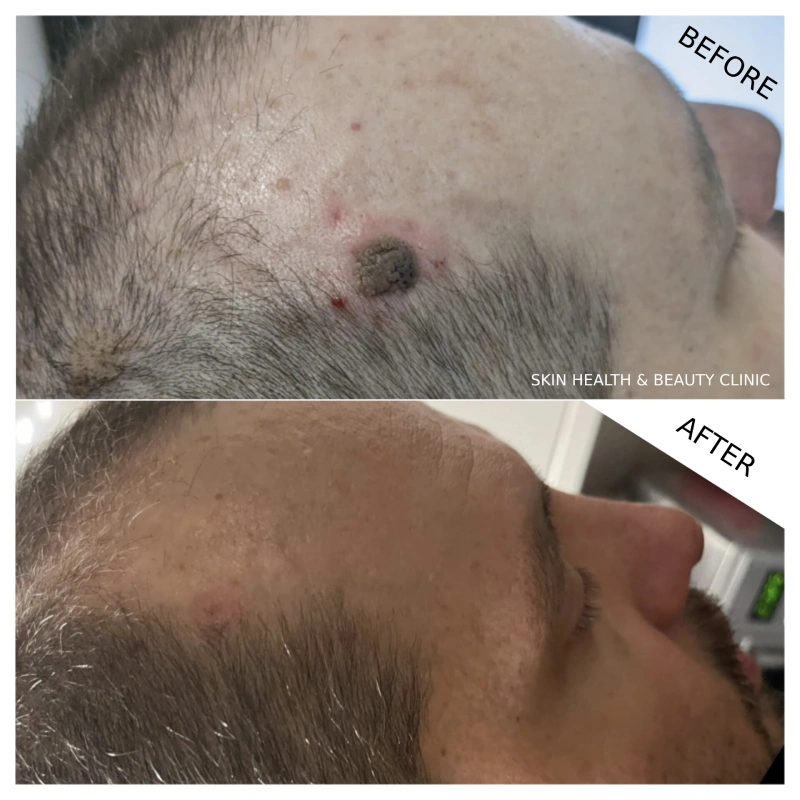Skin Health & Beauty Clinic
Mole Removal in Bournemouth

What Are Benign Moles And Why Should We Remove Them?
Benign moles, also known as nevi, are common skin growths composed of pigment-producing cells called melanocytes. These moles are typically harmless and can appear anywhere on the body, ranging in color from flesh-colored to dark brown or black. Benign moles usually have a regular shape and defined borders.
While most benign moles do not pose any health risks, there are reasons why some individuals may choose to have them removed:
Cosmetic Concerns: Some people opt to remove benign moles for cosmetic reasons, especially if they are large, raised, or located in visible areas.
Preventive Measures: Although benign moles themselves are not cancerous, some may have characteristics that resemble those of cancerous moles or melanoma. Removing suspicious moles can help prevent potential complications or reduce the risk of misdiagnosis.
Prevention of Irritation: Moles located in areas prone to irritation, such as those frequently rubbed by clothing or jewelry, may become irritated or inflamed. Removing these moles can alleviate discomfort and reduce the risk of complications such as infection.
Changes in Appearance: Any changes in the size, shape, color, or texture of a mole should be evaluated by a dermatologist. If a previously benign mole begins to exhibit concerning features, such as asymmetry, irregular borders, or rapid growth, it may indicate the development of skin cancer. In such cases, removal and further examination of the mole may be recommended for diagnostic and treatment purposes.
Personal or Family History of Skin Cancer: Individuals with a personal or family history of skin cancer, particularly melanoma, may choose to have benign moles removed as a precautionary measure to reduce their overall risk.
10 Benefits Of Removing Moles With Electrocautery
Precision: Electrocautery allows for precise removal of moles, minimising damage to surrounding healthy tissue.
Effective: Electrocautery is an effective method for removing moles, often achieving complete removal in a single session.
Minimal Bleeding: The cauterization process seals blood vessels as the mole is removed, reducing bleeding during and after the procedure.
Quick Procedure: Electrocautery typically requires less time compared to other methods of mole removal, making it a convenient option for both patients and healthcare providers.
Low Risk of Infection: The heat generated during electrocautery helps sterilize the area, reducing the risk of infection following mole removal.
Minimal Scarring: With proper technique, electrocautery can result in minimal scarring compared to other methods such as excision or shave removal.
Versatility: Electrocautery can be used to remove moles of varying sizes and depths, including larger and deeper moles that may be challenging to remove with other methods.
Local Anesthesia: Electrocautery procedures can often be performed under local anesthesia, reducing discomfort during the removal process.
Cost-Effective: Electrocautery is generally a cost-effective option for mole removal, especially for multiple moles or larger lesions.
Low Recurrence Rate: When performed correctly, electrocautery typically has a low recurrence rate, reducing the likelihood of moles regrowing after removal.


Contraindications of Removing Moles
-
Pregnancy: Electrocautery may not be recommended for pregnant individuals due to potential risks to the fetus.
-
Skin Infections: If the area around the mole is infected, electrocautery may exacerbate the infection or spread it to other parts of the body.
-
Blood Disorders: Individuals with certain blood disorders or bleeding disorders may not be suitable candidates for electrocautery due to the risk of excessive bleeding.
-
Implanted Devices: Electrocautery may interfere with the functioning of implanted medical devices such as pacemakers or defibrillators.
-
Allergies: Some individuals may be allergic to materials used during electrocautery, such as local anesthesia or disinfectants.
-
Certain Medications: Certain medications may increase the risk of complications during electrocautery procedures. It’s important to inform the healthcare provider about any medications being taken.
-
Immunocompromised Conditions: Individuals with weakened immune systems may have a higher risk of complications from electrocautery procedures.
-
Recent Sun Exposure: Recent sun exposure may increase the risk of complications and slow down the healing process after electrocautery.
-
History of Keloids: Individuals with a history of keloid formation may be at a higher risk of developing keloids at the site of electrocautery.
-
Uncertain Diagnosis: If the mole is suspected to be cancerous or if there are uncertainties regarding the diagnosis, electrocautery may not be appropriate until further evaluation is conducted.
Always consult with a your GP to confirm if your mole is benign.
FAQ
Frequently Asked
Is electrocautery a common method for benign mole removal?
Yes, electrocautery is a commonly used method for removing benign moles. It involves burning the mole tissue with an electric current.
Is electrocautery painful?
The procedure is usually done under local anesthesia, so you may feel some discomfort during the injection of the anesthetic. However, during the actual removal process with electrocautery, you shouldn’t feel pain.
How long does it take to recover from mole removal with electrocautery?
Recovery time varies, but generally, it may take a few days to a couple of weeks for the area to heal completely after mole removal with electrocautery.
Will there be scarring after mole removal with electrocautery?
Scarring can occur, but it depends on factors like the size and location of the mole, as well as the technique used during electrocautery. Your healthcare provider can advise you on how to minimize scarring.
Can moles grow back after removal with electrocautery?
In some cases, moles can grow back, especially if the entire mole wasn’t removed or if there were mole cells left behind. However, with electrocautery, the chances of recurrence are generally low.
Is mole removal with electrocautery covered by insurance?
It depends on your insurance plan and the reason for the removal. If the mole is deemed medically necessary, such as for cancer prevention or if it’s causing symptoms, insurance may cover it. However, if it’s purely for cosmetic reasons, you may need to pay out of pocket.
Opening Times
| Day | Hours |
|---|---|
| Monday | 10:00 - 14:00 16:00 - 20:00 |
| Tuesday | 10:00 - 16:00 |
| Wednesday | 10:00 - 14:00 16:00 - 20:00 |
| Thursday | 10:00 - 14:00 16:00 - 20:00 |
| Friday | 9:30 - 14:00 16:00 - 20:00 |
| Saturday | 10:00 - 17:00 |
| Sunday | 10:00 - 12:00 |
Clinic Address
878, Christchurch road, Bournemouth BH76DJ
Telephone
07393 770773
Finding us
Our clinic is located on the left hand side of Christchurch Road a few meters away from Kwik Fit towards Iford roundabout, just at the Hannington Road Bus Stop. There is plenty of transport link to Bournemouth, Poole and Chirstchurch all day and free parking outside the clinic for an hour and in the side roads unlimited.
